ORDER
Psittaciformes
FAMILY
Psittacidae
GENUS & SPECIES
key features
• Easily distinguished by snow-white plumage and large erectile crest of yellow feathers
• Lives in noisy and conspicuous flocks, but is difficult to approach as some flock members stand on lookout duty and quickly warn others of approaching danger
• Has a huge appetite for seeds and grain and is regarded as a pest of commercial crops
where in the world?
In woodlands and clearings in northern, southeastern and eastern Australia; widespread in New Guinea, except for central highland areas, Tasmania and islands of southeastern pacific
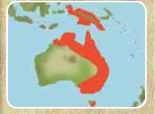
LIFECYCLE
The sulphur-crested cockatoo is a wary bird. It protects itself when feeding in a flock on the ground by posting lookouts in nearby trees to give early warning of danger.
HABITAT
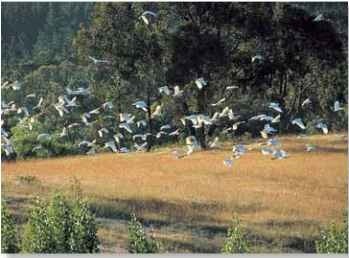
A Local color Flocks of sulphur-crested cockatoos rarely move far from their home patch and tend to stay in one locality year-round.
The cockatoo occupies a wide range of habitats in Australia and New Guinea, occurring in highland forests to 4,9507,920′, in eucalyptus forests, coastal mangroves and in savannah woodland.
In Australia, the species has become particularly common and widespread on farmland and, recently, has increasingly begun to move into urban areas during the winter: Some cities in eastern Australia, such as Sydney and Canberra, even have large resident flocks of sulphur-crested cockatoos living in the suburbs.
One-upmanship
The perching cockatoo is never far from trees.
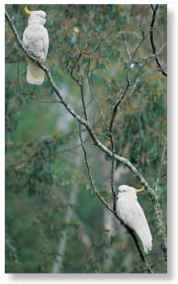
FOOD & FEEDING
Fruit, seeds, berries and nuts make up the main part of the sulphur-crested cockatoo’s diet.These are taken from a variety of trees and bushes and from the ground. The cockatoo also supplements its diet with flowers, leaf buds, insects and larvae.
Large flocks feeding in agricultural areas can cause considerable damage to commercial crops and the cockatoo is regarded as a pest in cereal-growing districts of Australia. However; as the same flocks also consume enormous quantities of weed seeds, such as thistles, which are an invasive farmland pest, the cockatoo’s feeding habits are also a benefit to farmers.
BREEDING
During the breeding season, the male performs a courtship ritual that involves strutting along a branch toward the female.With his crest raised, he bobs his head up and down and from side to side in a figure-eight pattern. If he does well, a session of mutual preening and bill-touching follows to cement the bond.
After mating, the female lays 2-3 white eggs. Hatching naked and blind five weeks later, young are fed by both parents. Young remain in the nest until they fledge at 10 weeks and fly out, dispersing to join a flock.
Tree house
Tree holes, or hollow trees, provide an ideal nest site.
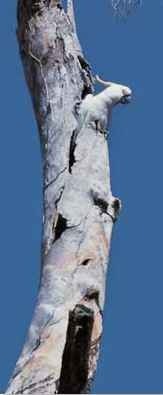
CONSERVATION
In parts of New Guinea, the sulphur-crested cockatoo is still hunted for its feathers. Elsewhere it’s often kept as a pet and despite the illegal capture of wild specimens, the species is in no immediate danger.
BEHAVIOR

A Undercover Trees provide roosts and shade from heat.
SAFETY IN NUMBERS

Departing…
Cockatoos spend the night in the safety of a roost. Squawking noisily, they set off at dawn, first to drink, then to feed.
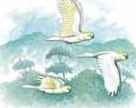
Surveying…
The birds spend some time surveying the land, searching for open areas where they can feed in safety on the ground.
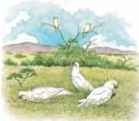
On guard…
While the main flock is feeding on the ground, several cockatoos keep a lookout from the tops of nearby trees.All is quiet until…

Beat it
a dingo appears on the scene. The sentries call raucously to alert the feeding birds, which immediately take to the air.
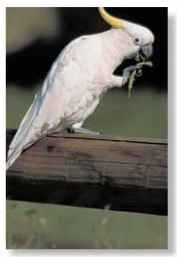
Foot and mouth The cockatoo often brings food to its bill with its feet.
Up and down
The cockatoo feeds in the trees and on the ground.
The sulphur-crested cockatoo’s eye color can reveal its sex — dark brown in males, reddish-brown in females.
The oldest captive bird in the world was a sulphur-crested cockatoo called “Cocky,” who died in London at the age of 82.
The cockatoo’s common and Latin name, Cacatua, stem from the Malayan word kakatoe: an imitation of the bird’s calls.
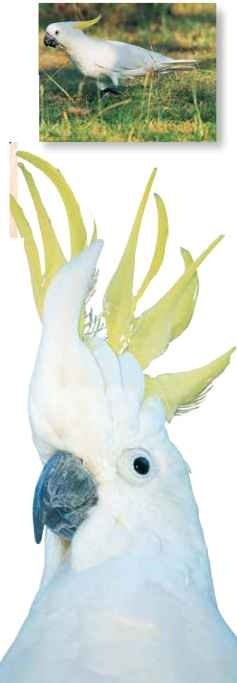
Crest
A sulphur-crested cockatoo uses its distinctive crest to reflect its mood. By raising its crest it may signal fear, aggression or sexual excitement.
In the northern part of its range, the cockatoo forms pairs or small groups all year In the south, it forms large flocks year-round, except in the breeding season.
At dawn, the sulphur-crested cockatoo leaves its roosting site, joining others screeching and shrieking to drink at a watering hole. Much of the day is spent feeding, but at the hottest time of day, the flock shelters in trees. Returning to the roosting site at dusk, individuals jostle and squawk noisily as they squabble over perching places.
Profile
Sulphur-crested Cockatoo
The sulphur-crested cockatoo, resplendent in its bright-yellow headdress, is equipped with a powerful, nut-cracking bill and highly dextrous feet.
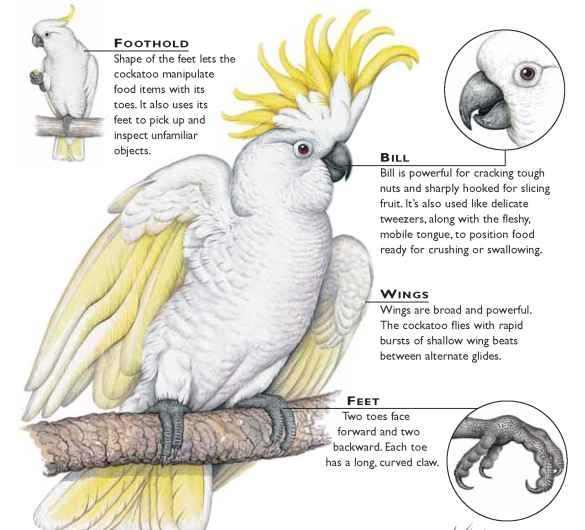
CREATURE COMPARISONS
Many parrots have a head crest, which, like the sulphur-crested cockatoo, they raise if excited.The cockatiel (Nymphicus hollandicus), which is smaller than the sulphur-crested cockatoo, has a fine, tapering crest. It’s found over Australia’s interior, usually near water
A cockatoo with an impressive, back-swept crest is the palm cockatoo (Probosciger aterrimus) of New Guinea and Australia’s extreme north. It also has the longest bill of all parrots.The bird is larger than the sulphur-crested cockatoo and is glossy black except for bare, reddish cheek patches, which turn deeper red when it becomes excited. Palm cockatoo


| vital | |
| statistics | |
| Weight | 28-35 oz. |
| Length | 18-20″ |
| Wingspan | 28-32″ |
| Sexual Maturity | 2-4 years |
| Breeding Season | May-Sept. in north; Aug.-Jan. in south |
| Number of Eggs Incubation period Fledging Period Breeding Interval Typical Diet |
2-3 36 days 10 weeks 1 year Fruit, seeds, berries, nuts, insects, larvae |
| Lifespan | 30-40 years in the wild |
Related species
• There are about 20 cockatoo species in the family Psittacidae, which also includes parrots and lories. Most cockatoos have a crest and are black or white with small splashes of other colors, but an exception f is the galah, Eolophus roseicapillus (below).


